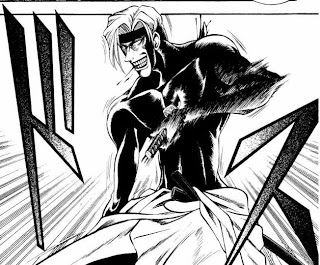The popular samurai manga RUROUNI KENSHIN ran from 1994 to 1999. Like other samurai adventure-stories, the series varies in mythopoeic quality from one story-sequence to another. In terms of structure, this manga, by artist-writer Nobuhito Watsuki, is a little more ambitious than some of the others I've addressed here, as it tends to use long arcs rather than episodes.
There's another aspect to this manga that seems ambitious to my mind, though I can't be sure how innovative RUROUNI was in its day, since I'm not an expert on the samurai manga-genre, or even on the subgenre that might be called "the samurai assassin." In two previous mythcomics-essays I've examined a few other assassin-stories-- respectively,
LADY SNOWBLOOD and
LONE WOLF AND CUB-- and both stories feature ambivalent heroes who have taken up the profession of assassin with an unbending, almost inhuman sense of dedication. Indeed, the Lone Wolf's most frequent metaphor for his life-path is
meifumado, a Japanese word translated as "the road to hell." However, RUROUNI focuses upon a former samurai assassin who is seeking some form of social redemption-- a way out of his personal hell, as it were.
RUROUNI's central character, Kenshin Himura, arrives in Tokyo in 1878, during the early years of the Meiji Restoration. He promptly becomes something akin to the "stranger with a past" who shows up in some city Out West, for though Kenshin wields a sword specially designed not to take lives, he constantly uses his skills to defend the innocent. It eventually comes out, though, that thirty years ago Kenshin was a
Hitokiri, an assassin who serves rebellious, anti-Shogunate forces. Appalled by his own actions, the former samurai becomes a wanderer. When he settles in Tokyo he draws to him a small coterie of oddball friends, one of whom, the lady Kaoru, is certainly the main reason he stays, as a constant romantic "will-they-won't-they" vibe exists throughout the series. Kaoru runs a dojo devoted to the mastery of the *
bokken* (wooden sword), and expouses the idea that someday the relative non-violence of the wooden sword will replace the deadly violence of the metal one. As a killer himself, Kenshin never believes that this is a real possibility, but he admires her naive idealism, her innocence in contrast to his own brutal experience.
Naturally, Kenshin's skills couldn't be tested if he simply mucked about Tokyo fighting wife-beaters and the like. I won't endeavor to detail the very complicated political struggle that enmeshes the samurai, but what I call the "Jin-E Arc" begins when another
Hitokiri, name of Udo Jin-E, shows up in Tokyo to perform a "hit."
As is usually the case in heroic adventure stories, the villain represents all the things that the hero hates or rejects. Jin-E is not only an assassin, but one who revels in carnage and death. Moreover, much like Batman's Joker, he feels challenged by the hero's rectitude. Once Jin-E has become aware of Kenshin's presence, he not only wants to beat him in a sword-fight, he also wants to force Kenshin into a situation where Kenshin revives his own "will to kill." This he does by capturing Kaoru in what seems a standard "damsel in distress" scenario.

Jin-E is also the first of many villains who have martial-arts powers that belong to the realm of the uncanny rather than the marvelous. In particular, Jin-E can overwhelm the will of other persons with his own mental strength, more or less after the fashion of a super-hypnotist. He binds Kaoru to his will, and then tells Kenshin that Kaoru, under his hypnotic control, will suffocate if Kenshin does not fight Jin-E with the full will to kill.
Naturally, threatening the hero's woman is a time-honored method for getting the hero to lose his cool.
Still, as the ferocious sword-battle erupts, Kenshin still does not go to the desired extremes, though he comes close to treading the way of hell once again. Kenshin is saved, however, by the "damsel in distress.
Though Kaoru is not a peerless warrior like the two assassins, she demonstrates a unique willpower of her own once she realized that Kenshin may be seduced into killing again. Once she breaks the hypnotic spell endangering her life, Kenshin can disable Jin-E without killing him.
However, Jin-R is entirely devoted to the cause of death, even if it's his own.
While the relationship of Kenshin and Kaoru is still not quite romantic love as such, implicitly the potential for love is clearly the 'secular redemption" that Watsuki offers his main character. I'm not claiming that Watsuki invented any wheels here, for manga-stories are rife with tales about heroes whose lovers and friends provide them with stabilizing, or even salvific, influences. But given the predominant pessimism seen in many of the popular samurai-dramas, it seems to me that Watsuki is rather radical in offering his readers a story of a bloody-handed killer who is able to renounce his past by focusing on performing "good deeds" in the present.






























